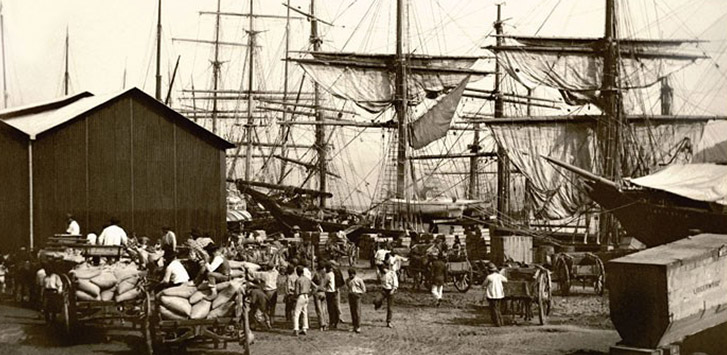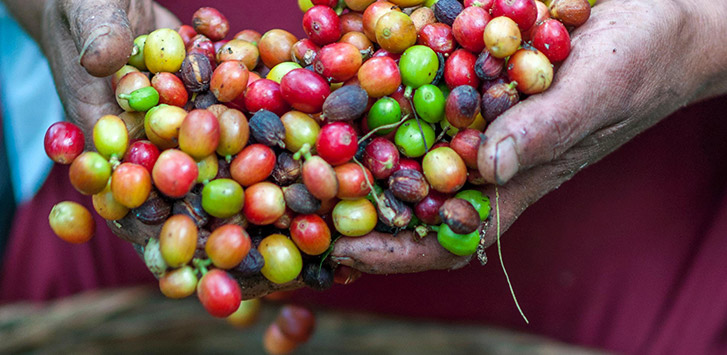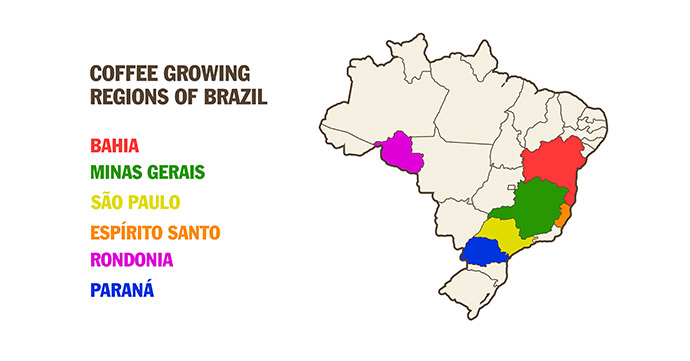
Brazil is known for being one of the largest single-origin coffees producing countries, as well as one of the largest consumers of coffee. While Brazil has a near-monopoly on the coffee market, Brazilian coffee may not be as complex as other varieties, but Brazil has both specialty blends and great espresso.
History of Coffee in Brazil
18th Century
Like many South American countries, coffee was brought to Brazil by a European. As the story goes, Portugal asked the French Guiana government for a couple of its coffee plants, but the French Guiana government refused.

At the time, Francisco de Melo Palheta was residing in French Guiana as a diplomat. Wooing the governor’s wife, he managed to acquire a bouquet with coffee seeds hidden inside. He carried the seeds back to Brazil, planting them in the state of Pará in 1727.
19th Century
The coffee industry quickly grew, due to the expanding slave labor on the plantations. By the 1830s, coffee was Brazil’s biggest export, and by the 1840s, due to the Haitian Revolution, Brazil became the largest coffee producer in the world. This era represents Brazil’s first coffee boom.
After slavery was abolished in 1888, conditions remained the same in Brazil. Historians have dubbed this time as a “second slavery,” a change in labor history, not labor practices.
With the Brazilian government focused on expanding exportation, human rights fell to the wayside. Harsh labor practices persisted, paving the way for continued racism and segregation. Former slaves continued to be the backbone of the coffee industry.

The 1880s to 1930s is a period in political history called “Café com leite” or “Coffee with milk.” The rise in the exportation of coffee and milk lead to great industrial leaps in the country, including a new railway system and increased immigration to major cities. This golden era ended when the global market received an oversupply of coffee, spurring on the 1930s Great Depression.
20th Century
The 20th century witnessed Brazil’s international dominance of the coffee industry, peaking in the 1920s with a market monopoly of 80%. Once the 1950s arrived, Brazil’s share began to decline, as other countries increased their output.
21st Century
The 1990s brought another wave of change, as the coffee industry catered to its customers’ developing preference for milder, higher-quality coffee. This prompted discussions around the International Coffee Agreement, which included decreasing export quotas and emphasizing quality. Brazil refused to reduce its quotas, causing the agreement to fall apart in 1989, dissolving the Brazilian Coffee Institute and deregulating the coffee industry.

Nowadays, Brazil focuses its efforts on establishing a Brazilian specialty coffee and growing multiple organic and fair trade certified coffees. Overcoming the land’s natural barriers has been no easy task. Unlike many prominent coffee-producing countries, Brazil doesn’t have the high altitudes or volcanic soil needed to grow a complex, well-rounded coffee bean. Nonetheless, Brazil remains the leading coffee producer today, growing mainly Arabica coffee.
Growing Regions & Cultivation

Unlike its competitors, Brazil is composed of low altitudes and a warm, tropical climate with little rainfall. What Brazil lacks in natural growing conditions, it makes up for with dry processing, creating new layers of flavor and complexity, adding body and sweetness to the otherwise average coffee bean.
The beans are harvested between May and September by large machines. Because of this harvesting style, farmers gather both ripe and non-ripe coffee beans, which has led others to call the ensuing coffee blends inferior.
Brazil’s coffee industry is made up of fourteen coffee-producing regions within six states; Minas Gerais, São Paulo, Espírito Santo, Bahia, Paraná and Rondonia.
Minas Gerais
Regions: Sul de Minas, Cerrado Mineiro, Chapada de Minas, and Matas de Minas
Minas Gerais has a mild climate and produces 50% of the total Brazilian coffee production. 60% of that is produced by small farms in the area.
The well-known Bourbon Santos variety is grown in Minas Gerais and Sao Paulo. It’s one of the medium-high quality coffees produced by Brazil, using a wet processing method, unlike most of the country.
São Paulo
Regions: Mogiana, Centro-Oeste, and Port of Santos
The Sao Paulo state boasts the highest coffee growing altitude in Brazil in the region of Mogaina at 900 – 1,000 meters above sea level.
Espírito Santo
Regions: Montanhas do Espírito Santo, and Conilon Capixaba
Espírito Santo produces the second-highest volume of coffee beans, primarily of the Robusta variety.
Bahia
Regions: Planalto da Bahia, Cerrado da Bahia, and Atlantico Baiano
Bahia is a newer coffee state, starting coffee production in the 1970s. However, its use of technology has made it a powerhouse in the past few decades. Focusing on irrigation systems and using the consistent weather to its advantage, Bahia grows remarkably uniform Arabica coffee.
Paraná
Regions: Norte Pionerio do Paraná
Rondonia Region
90% of Rondonia’s coffee is of the Robusta variety.
Flavor Profiles
Brazilian coffee beans have a general flavor profile that consists of a full-body, low acidity, and intense sweetness with notes of caramel, chocolate (ranging from milk chocolate to bitter cocoa), and a certain nutty flavor, reminiscent of toasted almond. Higher grade beans carry citrus notes and brighter, fruity characteristics.
Roasting Suggestions
Brazilian beans take to darker roasts well without becoming overly bitter because of the mild, well-balanced nature of the beans. Many choose to use these beans for espresso since they hold their taste well. A medium-dark roast (Vienna or Full City) is also a great choice.
Be careful as you roast the coffee beans! Brazilian coffee beans have a lower bean density, which can make roasting much more difficult if you’re not careful. Pay close attention at all times and apply a lower heat for a longer time to ensure a balanced roast.
Brewing Methods
When brewing Brazilian coffee beans, you want the coffee to achieve a full body with low acidity and notes of chocolate and toasted nut. There are three popular ways to go about this.
Espresso
The most common brewing method is making espresso blends with either the Bourbon Santos or Brazil Cerrado variety. Brazilian coffee beans are just naturally made for this.
Cold Brew
Brazilian beans in a cold brew create the perfect, smooth, refreshing drink.
French Press
A French Press is a full immersion brewer that is pairs well with the low acidic nature of Brazilian coffee and draws out the sweet chocolate notes and full-bodied characteristic.
Brazilian Coffee Recipe
Servings: 4
Ingredients:
4 cups hot cocoa
1 ½ cups strong Brazilian coffee
1 cup rum or brandy
½ cup heavy cream
1 tsp. sugar
Cinnamon (optional)
Directions:
Heat chocolate, coffee, and rum together until reach desired temperature.
Fold in sweetened whipped cream or put a spoonful on top of each serving.
Dust with cinnamon (optional).
Conclusion
As the world’s largest coffee producer, Brazil has left a great legacy in the world of coffee. With an emphasis on growth and learning, Brazil isn’t content to just let the coffee industry be run how it always has been, striving to grow quality, organic, fair-trade coffee.